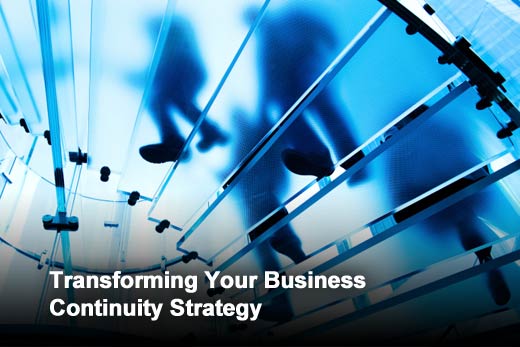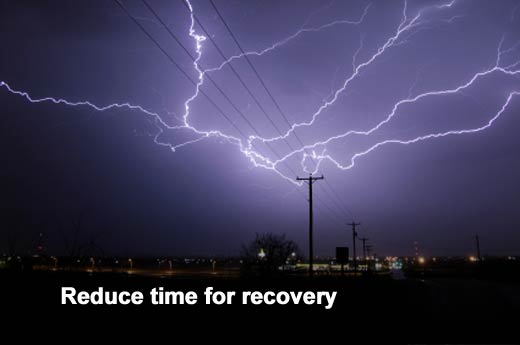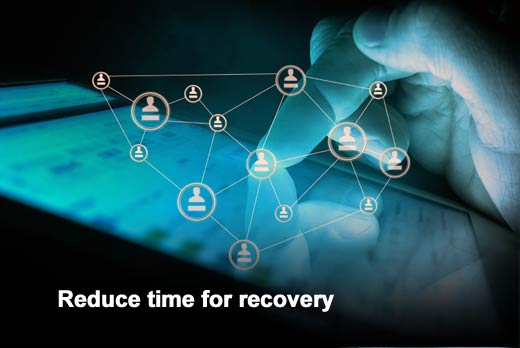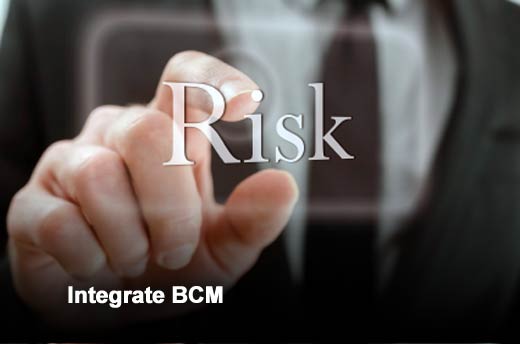Ingenious. Innovative. Intuitive. Complex. These are a few of the words one might use to describe today’s technology landscape. No doubt the last decade – and the last year – has ushered in some of the most advanced and awe-inducing technological feats – from apps, to robots, to delivery drones. Visionary men and women around the globe are leading us bravely into an entirely new technologically advanced world. But as the multitude of devices, advanced systems, and enterprise networks grow in size, scope, and complexity, the potential impact of natural and man-made disasters on individuals and organizations also grows exponentially. Effective disaster recovery planning is increasingly leveraging advanced technologies in a way that supports, strengthens, and streamlines the various processes, policies, and procedures needed to maintain business critical functions following a disruptive event.
In early November 2013, Typhoon Haiyan made landfall, ripping through the Philippines, killing thousands of people, displacing hundreds of thousands of others, and causing billions of dollars in damage. Over the last decade, natural disasters – from Hurricane Katrina, the Japan tsunami and earthquake, the Haiti earthquake – have all occurred with alarming frequency and increasing impact. Typhoon Haiyan is no longer considered the exception. It is not an anomaly, and we can expect to see more disasters of this size, scale, and magnitude in the future.
Overcoming the challenges of today while preparing for tomorrow requires that organizations focus their efforts and resources on three critical areas that will transform business continuity management (BCM) in 2014; gaining a 360-degree view of the interconnected and hyper-extended enterprise and supply chain, reducing time and tolerances for outages, and establishing an integrated BCM, business resilience risk management, security, incident management, and crisis management program.
In this slideshow, Yo Delmar, vice president, GRC Solutions, MetricStream, takes a closer look at the factors that are transforming business continuity management.
Click through for key drivers that are changing business continuity management, as identified by Yo Delmar, vice president, GRC Solutions, MetricStream.
Gain a 360-degree view of the interconnected and hyper-extended enterprise and supply chain to manage the ripple effect that one event can have on the business and across the supply chain.
No doubt today we are more connected to one another than ever before. Social media has given us unprecedented access to people, their conversations and their lives. Our businesses are also more inter-connected than ever before. The globalization of supply chains, emerging market opportunities, and an increasingly mobile workforce means we are traveling, networking, and collaborating in new and exciting ways.
Because of this, the concept of a “local” or “isolated” incident no longer holds true. Today, a natural disaster on one side of the world can unleash a ripple effect that is immediately felt across the globe, destroying workplaces, affecting power supplies, and damaging transportation and communication infrastructure. These effects often continue to ripple on beyond the disaster’s focal point. When the Gulf of Mexico coastline was ravaged by Hurricane Katrina, the resulting damage to oil rigs and refineries caused a sharp spike in oil prices, affecting the energy sector and end consumers across the nation. In light of this, the need for a technology-enabled platform that can manage proactive risk management, disaster recovery planning, and business continuity in tandem has never been more important.
Reduce time and tolerances for outages and recovery from days and hours to minutes and seconds by embedding digital in key processes.
According to the Centre for Research on the Epidemiology of Disasters (CRED), 357 natural-triggered disasters were registered in 2012 alone. Fortunately, this was less than the average annual disaster frequency observed from 2002 to 2011. Yet, 9,655 people were killed, and 124.5 million people were victims. Economic damages increased to above average levels at an estimated $157 billion. While the most immediate impact of a disaster is on human life and loss of human potential, there are secondary and tertiary consequences too, many of which can be felt for years. Since the 2010 Haiti earthquake, roughly 350,000 displaced Haitians live in tent camps; a cholera epidemic continues to rage across the country; and the unemployment rate has topped 70 percent.
Reduce time and tolerances for outages and recovery from days and hours to minutes and seconds by embedding digital in key processes.
One way to combat such devastation is through effective communication before, during, and after a disaster. This can make all the difference when it comes to the speed and efficiency of recovery efforts. When Hurricane Sandy struck the U.S., the public used social media to track the crisis in real time, and to direct resources where needed. Even the NYC fire department turned to Twitter to help identify emergency needs. By tapping into the power of social media, people are able to receive early warning messages in time, track real-time alerts from government sources such as FEMA, and receive real-time notifications on various topics, such as power availability. Emergency response personnel and volunteers are also better positioned to share information about the places that are most in need of relief, so that response efforts can be better prioritized.
Reduce time and tolerances for outages and recovery from days and hours to minutes and seconds by embedding digital in key processes.
Organizations leveraging technology solutions also have the ability to mine social media sites from sources such as Google Crisis Maps, Twitter, and Facebook and correlate social media insights with organizational assets and the associated risks. From the data, pre-designed workflows can be triggered in a way to best respond to, and manage the various financial, operational, and reputational implications of the crisis.
Integrate BCM with business resilience risk management, security, incident management, and crisis management in order to gain greater context around risk.
In the context of BCM, business resilience risk management, security, incident management, and crisis management all share a similar objective: to maintain the continuity of the business and business critical processes.
Advanced warning signals and systems can help organizations predict a disaster and its likely impact, rather than just react to it once it occurs. By trending various internal and external sources of data, organizations can get clues that help identify early warning signs, and accelerate planning efforts. Risk matrices and risk heat maps can create a clear picture of the data in order to develop meaningful insights and observations and identify the best response strategies. Integrating these end-to-end processes through a federated governance, risk and compliance (GRC) platform can help the organization achieve a near-real time picture. Integrating various efforts within a common GRC platform can also help support the creation of a common and shared risk and control framework, and uniform nomenclature and taxonomy for communicating risks, their likelihood, and impact.
Integrate BCM with business resilience risk management, security, incident management, and crisis management in order to gain greater context around risk.
The first step towards strengthening disaster resilience is to understand exactly who and what is at risk, as well as where, why, when, and how much. Therefore, contextualizing business continuity risk assessments and risk modeling is crucial. Not only can technology be used to help identify high-risk areas, but can also help quantify losses, and prioritize business continuity strategies and disaster recovery plans, efforts, and workflows.
Integrate BCM with business resilience risk management, security, incident management, and crisis management in order to gain greater context around risk.
Integration also supports the creation of a single crisis management and communications plan and specifies the resources required to successfully execute the plan, from interdependency diagrams and recovery scripts used by continuity and security professionals, to the training curriculum and educational programs for disaster recovery staff. Aligning key internal and external stakeholders on the organization’s recovery, mitigation, preparedness, and response strategies is critical.
Conclusion
Year 2014 will be marked by the increasing dependency on cross-functional and cross-industry collaboration, pooling strengths and exchanging of information and best practices. The increasing prevalence, convergence, and power of technology must be leveraged when it comes to business resilience, disaster planning, preparedness, and recovery efforts. Adopting a technology-enabled approach that can link various associated efforts can take risk management, reputation management and resiliency efforts to the next level. Preparing for a disaster is not something that can be done overnight. It takes months of effort, planning, engaging the right stakeholders, and leveraging the technology that can support better decision making around the strategies and tactics that work when we need them to.











